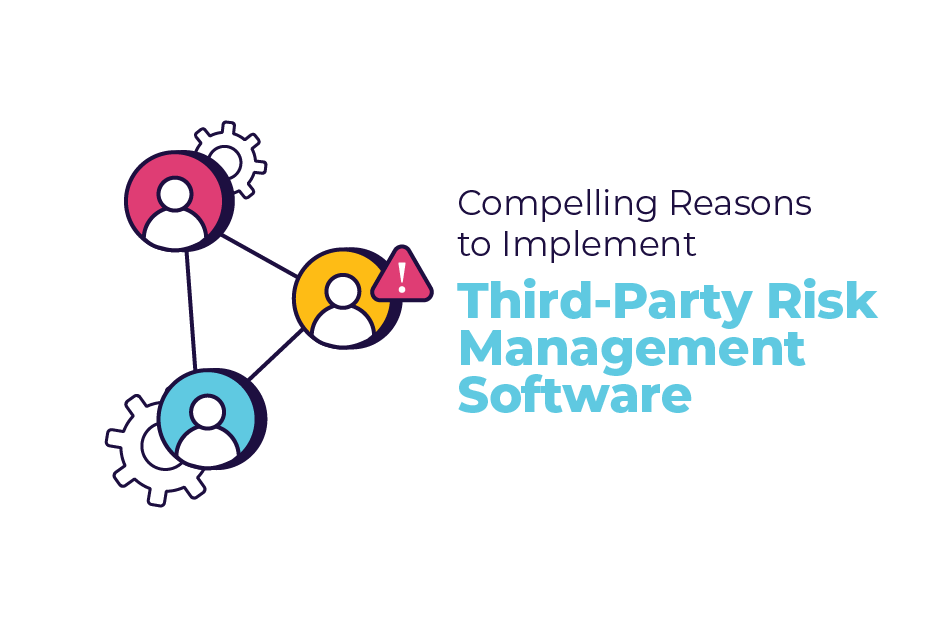Let’s be frank: most organizations boast an extensive third-party network. In fact, many daily operations will come to a sudden halt without the intricate involvement of trusted third-party tools.
But there’s a flip side: What data and information do they have access to, and what does it mean regarding your own security compliance? Still, no business is an island, and in modern times, running a business without the help of third-party tools or partners will only cause you to lag behind.
So, how can businesses leverage the growth opportunities and advantages of third-party relationships without adding an additional risk factor or vulnerability?
Easy! Third-Party Risk Management (TPRM).
What is Third-Party Risk Management?
Third-party risk management, also known as Vendor Risk Management, is the process of identifying, assessing, and reducing any security risks associated with a third-party business partnership. Naturally, when letting any external party into your inner circle, it’s imperative that they don’t expose you to any risks, threats, or unknown areas of noncompliance.
Although this may seem relatively straightforward on surface value, it gets exponentially more challenging as your business (and third-party network) scales. To help businesses get (and stay) compliant, TPRM software closes the gap and provides the necessary transparency and guidance into your vendor’s list to ensure that you’re protected from all angles, even the less obvious ones.
That is, however, if you do it correctly. But first, let’s look at why it’s essential to implement Third-Party Risk Management Software.
Why Implementing Third-Party Risk Management Software is Critical
Protect Your Business
Think you’re protected? Apparently not. In a recent study conducted by Gartner, up to
80% of compliance leaders identified third-party risks after the initial onboarding and due diligence phase. This tells us that there is a major gap in safeguarding data and security, even with a robust internal security standard.
Ultimately, safeguarding your business and sensitive data should be at the top of your priority list, but to do this effectively, you must be able to anticipate significant risks before they happen or, at the very least, have a substantial mitigation and remediation plan. TPRM software does just that, helping businesses reduce the risks that third-party breaches or violations will have on their own business and reputation.
Facilitate Compliance With Industry Regulations
Depending on your specific regulatory environment, TPRM may fall in your scope of compliance responsibilities. For example, if you handle PHI, you may be legally required to assess your third-party ecosystem to avoid being held liable for third-party incidents, even those that are beyond your control.
With the significant security impact that third-party vendors and partners can have on your business, most compliance frameworks and security standards require third-party risk management as a mandatory security control. With a TPRM software, businesses can rest assured that their blindspots are protected and that they aren’t liable or exposed to areas of non-compliance.
Seize Growth Opportunities
Third-party unreliability has the potential to cause severe organizational disruptions. To add to this, as the business environment changes at a rapid pace, so does the threat landscape, and mitigating these threats and risks require new approaches to ensure that they align with your business goals and growth opportunities.
TPRM software has the capability to identify and alert executive leadership in the event of any risks or security breaches, enabling prompt action while providing an effective remediation plan. This ensures that business operations don’t need to be put on pause due to third-party negligence. In addition, it also provides the opportunity for businesses to scale at ease, knowing they aren’t growing their risk exposure at the same time.

Critical Components of Effective TPRM Framework
As businesses and their business partners differ, various TPRM frameworks cater to different business requirements, ranging from simple, manual procedures to fully integrated third-party risk management software solutions. Regardless, there are a few core elements that need to be present in any TPRM framework.
- Risk Assessment
Reputation and rapport go a (very) long way, especially regarding information security. Therefore, it’s imperative that you assess the security posture of your past, current, and any potential third-party vendors and providers. This is best done by conducting a vendor risk assessment (VRA), which helps you gain a better understanding of the niche risks, opportunities, and red flags relevant to each vendor.
- Risk Monitoring
When it comes to TPR, it’s important to note that it’s not a one-and-done task. In fact, it requires continuous monitoring of the risk landscape. Therefore, it is essential to implement tools and techniques that track, assess, and analyze risk factors over time. This allows businesses to stay informed and proactively mitigate any emerging risks or potential vulnerabilities in their third-party relationships throughout their journey – not just during onboarding.
- Vendor Criticality
Any effective TPRM framework should clearly identify and lay out the vendor risk criticality. This means evaluating each vendor’s inherent risk and their importance.
Usually, organizations divide vendors into two groups:
- Critical: These are vendors whose products or services directly affect daily business operations. If they suddenly disappear, it could negatively impact customers or cause significant service interruptions.
- Non-Critical: These vendors offer products or services that don’t directly affect daily business operations. If they suddenly disappear, it won’t harm customers or cause significant service disruptions.
Prioritizing these helps management with resource allocation and decision making in terms of which vendors are worth the added security risk and which aren’t.
GET COMPLIANT 90% FASTER WITH AUTOMATION
Manage Third-Party Risk on Autopilot With Scytale
71% of organizations report that their third party network now contains significantly more vendors than it did three years ago. But as your business grows and your tool stack grows along with it, keeping continuous tabs on all your vendors or partners can be time-consuming and draining.
Unfortunately, traditional third-party risk management processes lack the strong continuity, flexibility and adaptability needed across all vendors to ensure they’re all held to the same standard.
The solution? For TPRM to be truly effective, it must become part of your compliance and security culture. Fortunately, you don’t have to carry the administrative weight alone. That’s why we’re here.
Manage your third-party risk without breaking a sweat (or regulatory requirement). With Scytale by your side, businesses can rest assured that nothing slips through the cracks, knowing they’ve implemented due diligence in regard to third-party risk, allowing your vendors to become another strength you can rely on instead of your weakest link.
Find out more about our automated vendor risk assessments here.










